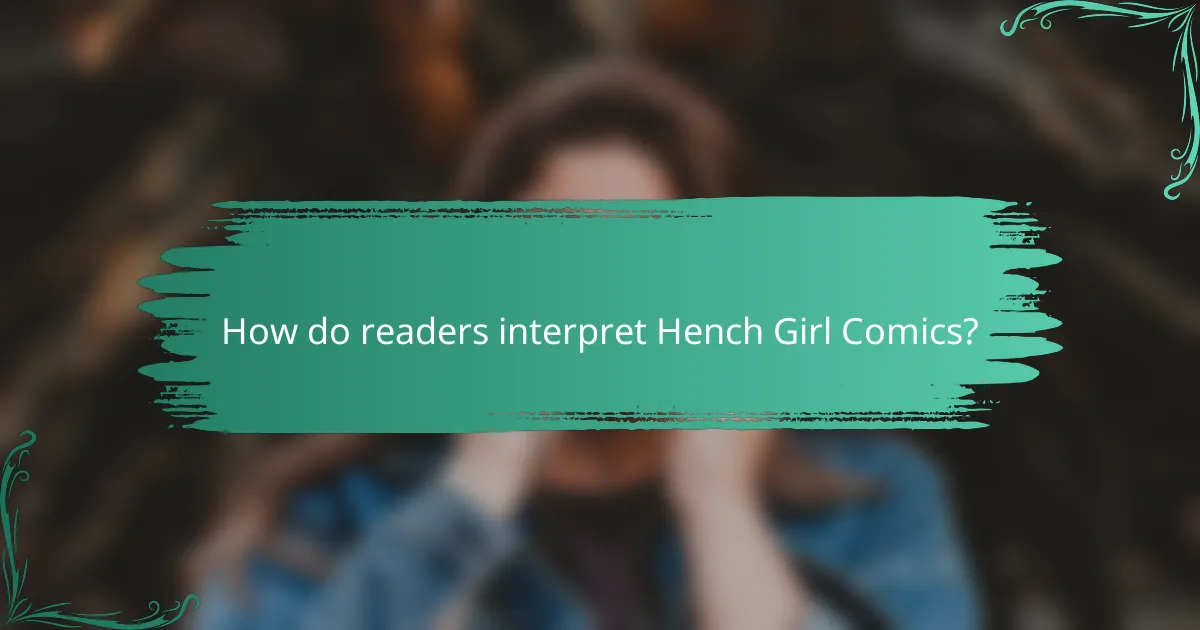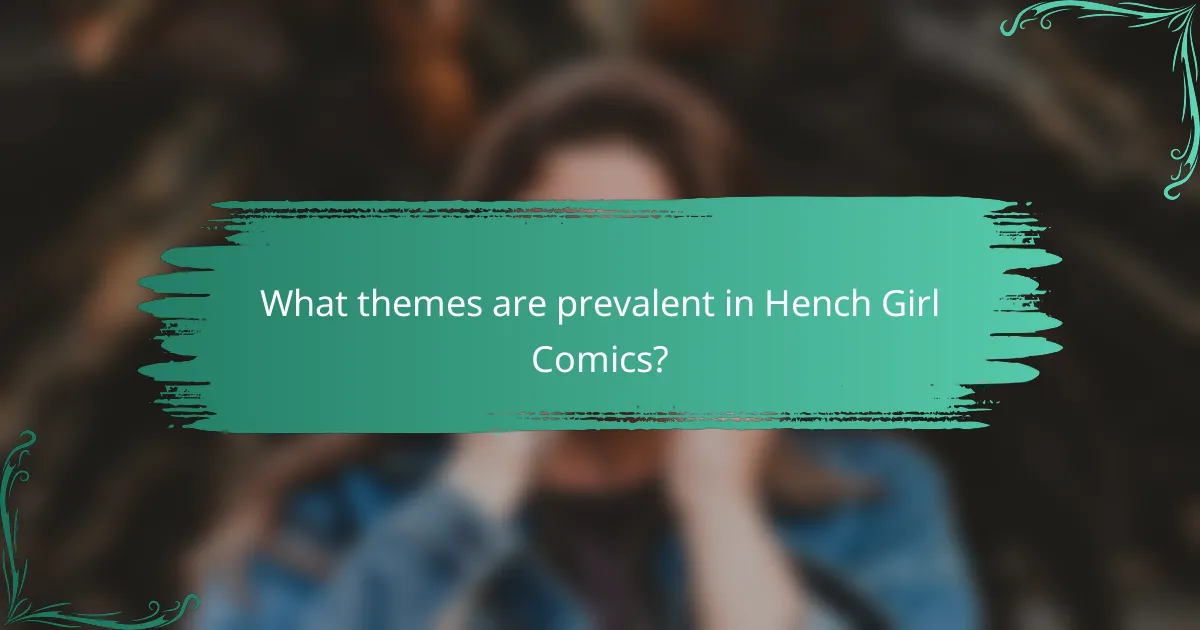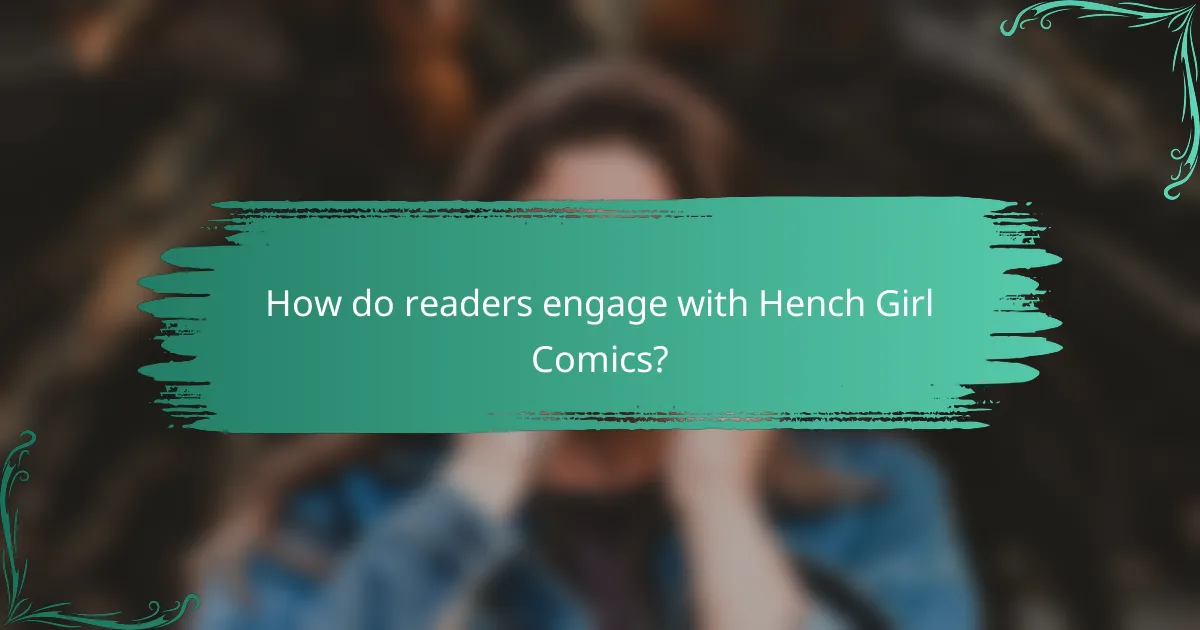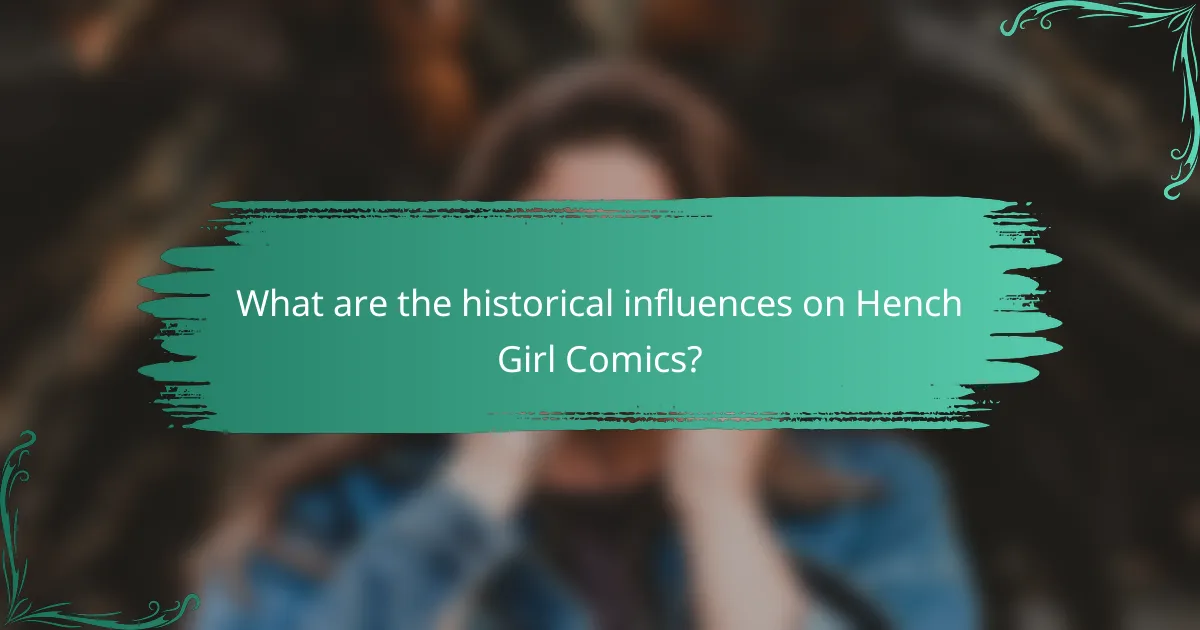Hench Girl Comics invite readers to explore rich themes of empowerment, feminism, and morality through engaging character development and visual storytelling. The diverse interpretations reflect personal experiences and societal contexts, fostering discussions about gender roles and ethical dilemmas. As readers connect through various platforms, they contribute to a vibrant community that enhances their understanding and appreciation of the narrative.

How do readers interpret Hench Girl Comics?
Readers interpret Hench Girl Comics through various lenses, focusing on character development, themes of empowerment, and visual storytelling. These interpretations often reflect personal experiences and societal contexts, enriching the overall narrative.
Character motivations
Character motivations in Hench Girl Comics are often complex, revealing deeper layers of personality and conflict. Readers may see motivations driven by loyalty, ambition, or the desire for acceptance, which can resonate with their own life experiences. For example, a character’s choice to support a villain may stem from a need for belonging rather than a simple desire for power.
Understanding these motivations allows readers to connect with the characters on a more personal level, fostering empathy and engagement. Analyzing the backstories and relationships can provide insights into why characters make certain choices, enhancing the reading experience.
Themes of empowerment
Themes of empowerment are central to Hench Girl Comics, often showcasing characters who defy traditional roles. Readers may interpret these themes as a commentary on personal agency and the pursuit of one’s identity, especially in a world that often marginalizes certain voices. Characters who rise against oppressive forces can inspire readers to reflect on their own struggles and triumphs.
Empowerment is frequently depicted through character arcs that emphasize growth and resilience. For instance, a hench girl who transitions from a sidekick to a leader embodies the journey of self-discovery and strength, resonating with audiences seeking representation and motivation.
Visual storytelling techniques
Visual storytelling techniques in Hench Girl Comics play a crucial role in conveying emotions and themes. Readers often note the use of color, panel layout, and character expressions to enhance the narrative. For example, vibrant colors may signify empowerment, while darker tones can represent conflict or despair.
Effective use of visual elements can guide the reader’s emotional response and understanding of the story. Techniques such as dynamic action sequences or close-up shots of characters’ faces can create a sense of urgency or intimacy, drawing readers deeper into the narrative. Recognizing these techniques can enrich the reading experience and foster a greater appreciation for the artistry involved.

What themes are prevalent in Hench Girl Comics?
Hench Girl Comics often explore themes such as feminism, morality, and friendship, reflecting complex social dynamics. These themes resonate with readers, prompting discussions about gender roles, ethical dilemmas, and the importance of loyalty in relationships.
Feminism and gender roles
Feminism in Hench Girl Comics challenges traditional gender roles by portraying female characters in diverse, empowered positions. The narratives often subvert stereotypes, showcasing women not just as sidekicks but as central figures with agency and depth.
For instance, female villains and henchwomen are depicted with their own motivations and struggles, allowing for a nuanced exploration of what it means to be a woman in a male-dominated world. This representation encourages readers to question societal norms and consider the impact of gender on personal identity.
Morality and ethics
Morality and ethics are central to the storylines in Hench Girl Comics, often presenting characters faced with difficult choices. These comics delve into the gray areas of right and wrong, prompting readers to reflect on their own values and the consequences of their actions.
Characters may grapple with loyalty to their employers versus their personal beliefs, illustrating the complexities of ethical decision-making. This theme invites readers to engage in discussions about morality in both fictional and real-world contexts.
Friendship and loyalty
Friendship and loyalty are key themes that shape the relationships between characters in Hench Girl Comics. The bonds formed among characters often highlight the importance of trust and support, even in morally ambiguous situations.
These comics frequently depict how loyalty can be tested, whether through betrayal or conflicting interests, making the exploration of friendship both relatable and compelling. Readers are encouraged to consider how loyalty influences their own relationships and the choices they make.

How do readers engage with Hench Girl Comics?
Readers engage with Hench Girl Comics through various platforms that facilitate discussion, sharing, and creativity. These interactions help build a community around the comic, allowing fans to express their interpretations and connect with each other.
Online discussion forums
Online discussion forums serve as a primary hub for fans to analyze and debate themes within Hench Girl Comics. Platforms like Reddit and specialized comic forums allow users to post theories, share insights, and ask questions about character motivations and plot developments.
Engagement in these forums often leads to deeper understanding and appreciation of the comic’s nuances. Readers can participate in ongoing discussions or start new threads to explore specific aspects that resonate with them.
Social media interactions
Social media platforms, such as Twitter and Instagram, are vital for real-time engagement with Hench Girl Comics. Fans often share their favorite panels, quotes, and personal interpretations, which can spark conversations and attract new readers.
Using hashtags related to the comic can enhance visibility and encourage broader participation. Engaging with creators through comments or direct messages also fosters a sense of connection and community among fans.
Fan art and community contributions
Fan art and community contributions play a significant role in how readers engage with Hench Girl Comics. Artists often create illustrations inspired by the comic, showcasing their unique interpretations and expanding the visual narrative.
These contributions can be shared on platforms like DeviantArt or Tumblr, where they can gain traction and inspire further creativity within the community. Participating in art challenges or themed contests can also enhance engagement and encourage collaboration among fans.

What are the key characteristics of Hench Girl Comics?
Hench Girl Comics typically feature a unique blend of humor, action, and character development, often focusing on the lives of sidekicks or henchmen in the superhero genre. These comics explore themes of loyalty, identity, and the often-overlooked perspectives of secondary characters in a vibrant and engaging manner.
Art style and design
The art style in Hench Girl Comics is often characterized by bold colors and exaggerated expressions, which enhance the comedic and dramatic elements of the story. Artists frequently employ a cartoonish aesthetic that appeals to a wide audience, making the characters relatable and memorable.
Design elements may include dynamic panel layouts that reflect the pacing of action sequences, as well as creative use of visual metaphors to convey themes. This approach allows readers to engage with the narrative on multiple levels, appreciating both the artistry and the storytelling.
Narrative structure
Narrative structures in Hench Girl Comics often deviate from traditional hero-centric plots, focusing instead on the challenges faced by hench characters. These stories typically blend episodic adventures with overarching themes, allowing for character growth and development throughout the series.
Common storytelling techniques include flashbacks and nonlinear timelines, which provide context for character motivations and backstories. This complexity adds depth to the narrative, making it more engaging for readers who appreciate layered storytelling.
Character diversity
Character diversity is a hallmark of Hench Girl Comics, showcasing a wide range of backgrounds, abilities, and personalities. This inclusivity not only reflects real-world diversity but also enriches the narrative by introducing various perspectives and experiences.
By featuring characters from different ethnicities, genders, and orientations, these comics challenge stereotypes and offer fresh takes on traditional superhero tropes. This diversity fosters a more relatable and engaging reading experience, appealing to a broader audience.

How do Hench Girl Comics compare to other comic genres?
Hench Girl Comics stand out by blending elements of traditional superhero narratives with unique character-driven stories. They often explore themes of loyalty, identity, and morality, setting them apart from other comic genres.
Similarities with superhero comics
Hench Girl Comics share several traits with superhero comics, primarily their focus on action and conflict. Both genres often feature larger-than-life characters and dramatic story arcs, where the protagonist grapples with moral dilemmas. For example, the hench girl may struggle with her loyalty to a villain while questioning the ethics of their actions.
Additionally, both genres utilize vibrant artwork and dynamic panels to convey excitement and tension. The visual storytelling in Hench Girl Comics often mirrors the dramatic flair found in superhero comics, enhancing the reader’s engagement.
Differences from slice-of-life comics
Unlike slice-of-life comics, which focus on everyday experiences and character development, Hench Girl Comics delve into fantastical elements and heightened stakes. The narrative often revolves around extraordinary situations, such as heists or battles, contrasting with the mundane scenarios typical in slice-of-life tales.
Moreover, the pacing in Hench Girl Comics tends to be faster, driven by action and plot twists, while slice-of-life comics may take a more leisurely approach to character exploration and emotional depth. This difference in pacing affects how readers connect with the characters and their journeys.
Cross-genre influences
Hench Girl Comics often draw inspiration from various genres, including fantasy and crime, creating a rich tapestry of storytelling. This cross-genre influence allows for diverse narratives that can appeal to a broader audience. For instance, a hench girl might navigate the criminal underworld while also dealing with supernatural elements, adding layers to her character.
Furthermore, the blending of genres can lead to innovative storytelling techniques, such as incorporating humor or social commentary. This versatility not only enriches the narrative but also invites readers to engage with the material on multiple levels, making Hench Girl Comics a unique and compelling genre in the comic landscape.

What are the historical influences on Hench Girl Comics?
Hench Girl Comics draw from a rich tapestry of historical influences, including the evolution of comic book culture, feminist movements, and the portrayal of sidekicks in superhero narratives. These influences shape the themes and character dynamics found within the genre.
Origins in comic book culture
The origins of Hench Girl Comics can be traced back to the early days of comic book culture, where sidekicks and villains often played supporting roles. Characters like Robin and various henchmen provided a backdrop for the main heroes, often lacking depth and agency.
As comic book narratives evolved, the portrayal of these supporting characters began to shift. Writers started to explore the lives and motivations of hench girls, transforming them from mere side characters into complex individuals with their own stories and struggles.
This shift reflects broader trends in storytelling, where diverse perspectives are increasingly valued. Readers now seek more nuanced portrayals that challenge traditional gender roles and explore the dynamics of power and loyalty within the superhero genre.
